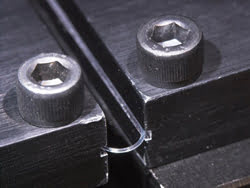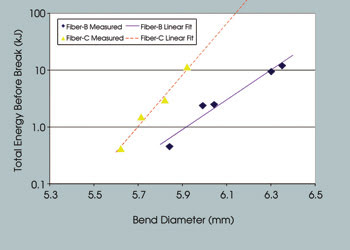Technology enables optical fibers to withstand high power and tight bends.
Dr. Xiaoguang Sun and Mick Speciale, OFS Specialty Photonics
Silica optical fibers have a long history of delivering laser energy in surgical, aesthetic, dental and sensing medical applications. Today’s lasers use higher power levels in lithotripsy (the procedure that breaks up kidney stones), benign prostatic hyperplasia treatment and laser-based cosmetic procedures. With advances in laser technology and the increasing flexibility of the scopes used to introduce many of these fibers, it becomes critical that fibers handle higher energy at extreme bends.

Figure 1. Here the detail of the fiber can be seen as it is bent into a tight diameter.
The typical fiber for laser delivery is a step-index multimode filament that has a pure silica core with fluorine-doped silica cladding or has a germanium-doped silica core with pure silica cladding. Originally designed to be used with semirigid scopes at lower power levels, today’s fibers can be damaged when bent while transmitting high-power laser energy. This happens either when energy escapes the core of the fiber into the cladding or when energy that has been contained in the cladding affects the secondary coating, which in turn can lead to damaged fibers and scopes.
Two tests conducted by OFS Specialty Photonics examined the performance of three fibers under bend and at high power at the 2140-nm wavelength (typical of lithotripsy applications):
• Fiber A: 365-μm pure silica core, 400-μm fluorine-doped cladding, standard hard clad silica (HCS) (a proprietary fluoroacrylate coating), 0.22-NA (numerical aperture) core.
• Fiber B: 365-μm pure silica core, 400-μm fluorine-doped cladding, HCS coating optimized for power handling, 0.22-NA core.
• Fiber C: 365-μm germanium-doped core, 438-μm pure silica cladding, optimized HCS fiber coating, 0.29-NA core.

Table 1. The comparison is shown of median breaking diameter with and without power, and initial fiber strength.
Each fiber was subjected to a bend test to measure fiber strength and minimum bend diameter, with and without laser energy. Although the mechanical strength of the fibers was close, the breaking diameters under power for fibers A and B were very different (Table 1). The only difference was the type of coating, which indicates that the polymer coating plays an important role in this damage mode. With the fluoroacrylate coating, cladding modes are preserved through bends, distributing lost power over a greater area and lowering the probability of “hot spots,” a key characteristic for high-power laser delivery applications.
Total transmitted power
The second test measured the total transmitted power before fracturing when a fiber is bent to a fixed diameter (Figure 2).

Figure 2. The total power transmitted until the fiber fractures is recorded at bend diameters from 5.5 to 6.5 mm. The figure plots the total transmitted power versus the bend diameter for fibers B and C. (Fiber A is not shown because it broke at 10 mm instantly when 100 W was launched into it.)
Fiber C transmitted more power than fiber B. The differences in total transmitted energy are not related to the HCS coating but to the structure of the fiber itself. Fiber C has a higher NA and a higher index difference between the glass cladding and the polymer coating. Therefore, the bend loss from the core is lower in fiber C.
Tight bends and high power levels place additional stress on optical fibers. This investigation of the performance of fiber under bend and high power finds that both the structure of the fiber and the coatings applied to it play a significant part in performance and reliability. Fibers with low bend loss and optimized low-index coating are better suited for laser power delivery under tight bending. This combination has been shown to reduce coating absorption and stress and to increase the threshold of laser-induced damage. This is even more critical when the device is used multiple times and subjected to multiple sterilization cycles and surgeries.
Meet the authors
Xiaoguang Sun is a fiber development engineer and Mick Speciale the medical market manager, both at OFS Specialty Photonics, Avon, Conn.; e-mail: [email protected]; mailto:[email protected].